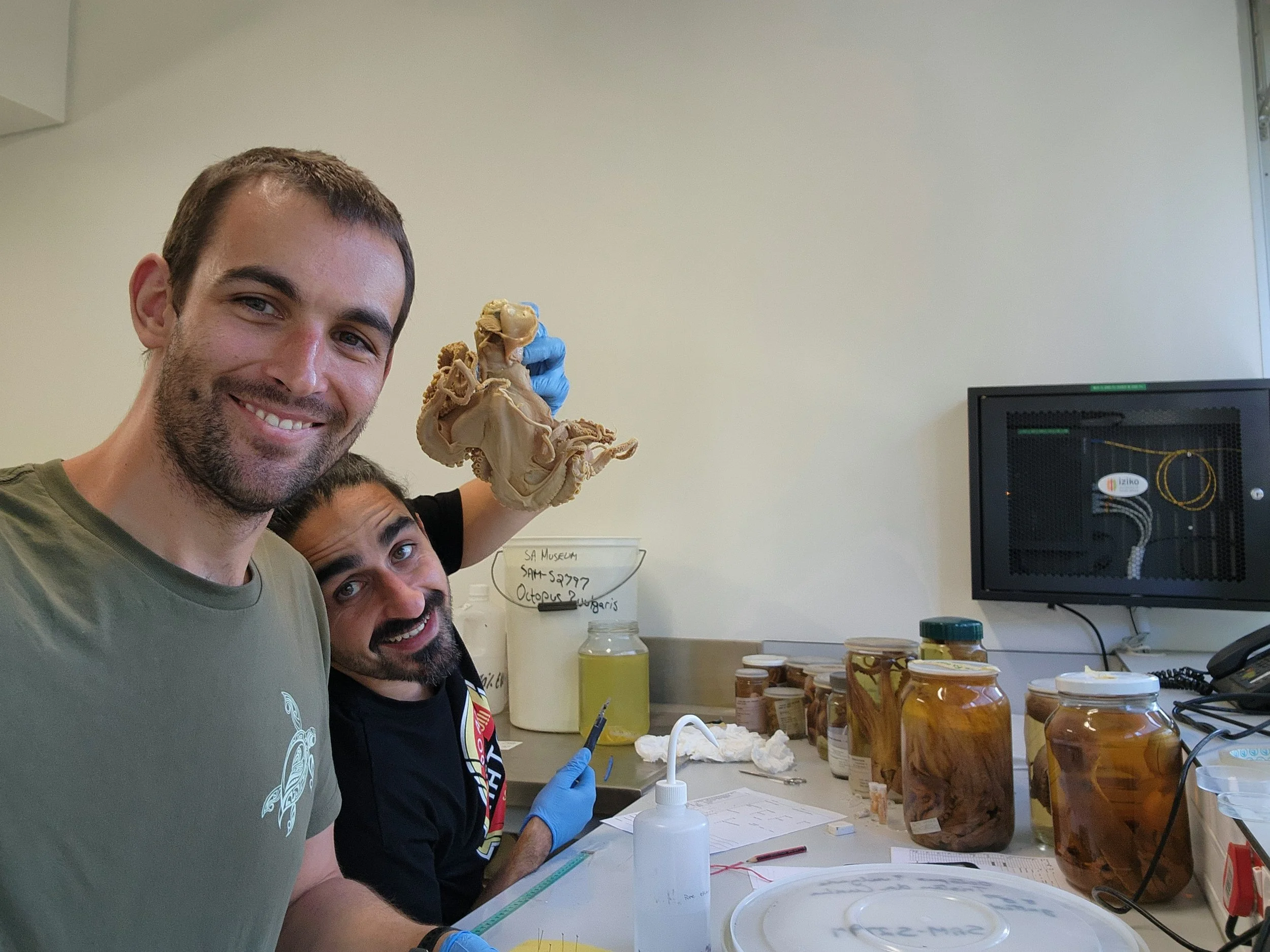Current research
Honorary Associate – Royal Botanic Gardens Victoria
Research Associate – Aquatic Zoology, Western Australian Museum
My research is focused on conservation. I study species-level relationships and the biogeographic events that shape them. I also have a keen interest in the genetic diversity and structure of populations.






Species description: Octopus djinda, WA’s common octopus
Octopus djinda Amor, 2021 belongs to the world’s most studied, and valuable group of octopuses. My past genetic- and morphology-based research shows that O. djinda is unique to Western Australia and likely diverged from its east coast relative, the gloomy octopus, Octopus tetricus, within the last 7–2 million years. I have formally descibed O. djinda, providing scientific and common names.
The star octopus finally has its own fisheries management plan and catch statistics reporting. Globally, it is one of only two octopus fisheries with sustainable certification from the Marine Stweardship Council.
Etymology: Octopus djinda, the star octopus, is distributed along the southwest coast of Australia. This distribution closely reflects the territory of the traditional custodians of this land, the Nyoongar people (‘a person of the southwest of Western Australia’). To recognise their connection to this land, a Nyoongar translation of ‘star’ (djinda), as described by Whitehurst (1997), was selected as a species name. This use of ‘star’ (luminous) reflects the shared recent ancestry with, and now-understood distinction from, O. tetricus (Latin: gloomy octopus).
Consultation with the Aboriginal community regarding the use of ‘djinda’ as a species name was undertaken via the Western Australian Museum’s Aboriginal Advisory Committee (WAMAAC). Initial documentation, including the above etymology statement, was presented to the committee on Friday July 2, 2021. Support was provided on July 14, 2021.
My role: Species authority
Collaborators:
Anthony Hart - Department of Primary Industries & Regional Development
Funding: Australian Government, Fisheries Research and Development Corporation (FRDC).
Image of octopus on seagrass: Dr Mark Norman
Download: paper
Media: New Scientist | Sydney Morning Herald
Genetic rescue of the endangered guthega skink, Liopholis guthega
The Guthega skink is critically endangered in Victoria and listed as nationally endangered under the federal Environment Protection & Biodiversity Conservation Act 1999.
We have previously published work showing that increased temperatures have restricted populations of Liopholis guthega to ‘sky-islands’, which has created barriers to gene-flow. Increasing human presence, feral species and frequency of wildfire have contributed to population decline and local extinctions.
Our current project aims to improve captive breeding success and investigate the efficacy of genetic rescue for increasing genetic diversity in wild populations.
My role: Lead geneticist and bioinformatician
Collaborators:
Zak Atkins - Snowline Ecology
Nick Clemann - Zoos Victoria
Funding: Zoos Victoria; Department of Environment, Land, Water and Planning (DELWP); Australian Alps National Parks.
Clinging to life: conservation of the critically endangered tea-tree fingers
Tea-tree fingers (Hypocreopsis amplectens) is a rare and cryptic fungus that typically occurs at low densities. Hypocreopsis appear to be obligate myco-symbionts—forming finger-like, clasping sporing bodies in the presence of wood rotting fungi (family Hymenochaetaceae). This host fungus requires dead branches of shrubs and small trees, such as Leptospermum, Melaleuca and Kunzea. A complex life history, combined with the extensive loss of suitable habitat have led to tea-tree fingers being one of Australia’s most threatened fungi (Critically Endangered - IUCN Red List; Victorian Flora and Fauna Guarantee Act).
I recently led a world-first study incorporating a wildlife detection dog into fungal conservation. We benchmarked the effectiveness of a wildlife detection dog against a highly skilled human when searhing for one of the rarest fungi in the world. Our detection dog, Daisy, outperformed our expert human surveyor, Shari, finding more fungi in less time. Importantly, the combined human and dog effort provided a 95% detection rate, meaning that our team can be extremely confident that our searches are effective—an important metric when most searches result in no fungi being found.
My role: Lead scientist
Funding: Department of Environment, Land, Water and Planning; Parks Victoria; Indianapolis Zoological Society
Partners: Royal Botanic Gardens Victoria; Zoos Victoria
Download: Detection dog paper
Images include Daisy in her work uniform and GPS collar, her handler, Dr Nick Rutter, from the Zoos Victoria Detection Dog Program and Shari Barmos.
Sclerolaena napiformis: An endangered Murray Darling native
Sclerolaena napiformis has declined in abundance due to habitat clearing and has recently been listed as nationally endangered. Investigating the population structure and health of this species will enable us to identify sites with relatively high genetic diversity and populations that require protection.
My role: Geneticist and bioinformatician
Collaborators:
Liz James, Neville Walsh - Royal Botanic Gardens Victoria
Funding: Australian Federal Government
Download: Paper
Octopus vulgaris: genome-wide phylogenetics of cryptic species
My recent molecular and morphological work shows that the Octopus vulgaris complex is made up of several cryptic species. However, investigating mitochondrial DNA only gives us a small view of the overall genetic diversity among species. All of your genes define who you are. Therefore, we aim to obtain sequence data from across the entire nuclear genome to conduct the most extensive comparison of genetic diversity among members of the O. vulgaris species group. We will then compare this to the signal obtained via analyses of mitochondrial DNA.
After a global sampling effort, we are using double digest RADseq to obtain sequence data from across the nuclear genome. We will construct a phylogeny and determine the proportion of the genome that supports it. We will also test its topology likelihood against previous mitochondrial DNA-based trees. Finally, we will perform species tree estimation and date the divergence of each species in the O. vulgaris species group.
Download: Pre-print

























